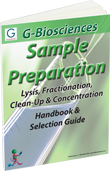 Agarose beads are small spherical beads of agarose gel which are commonly used in gel filtration or molecular size exclusion chromatography and biomolecular purification and immobilization. These beads act as porous gel to filter mixtures of molecules based on their individual sizes. And since these beads are easy to activate, they can also be used to bind biomolecules in a reversible or irreversible manner. In addition, their inert nature and unique internal surface area can also be activated for ligand attachment, making them the ideal basis for various affinity chromatography beads such as protein A and G, and glutathione.
Agarose beads are small spherical beads of agarose gel which are commonly used in gel filtration or molecular size exclusion chromatography and biomolecular purification and immobilization. These beads act as porous gel to filter mixtures of molecules based on their individual sizes. And since these beads are easy to activate, they can also be used to bind biomolecules in a reversible or irreversible manner. In addition, their inert nature and unique internal surface area can also be activated for ligand attachment, making them the ideal basis for various affinity chromatography beads such as protein A and G, and glutathione.
Some researchers are confused whether they should use agarose or Sepharose beads for their experiments but this really doesn't matter since both refers to the same product. Sepharose is just a registered trademark for agarose beads used by GE Healthcare.
Understanding the Key Differences between 2%, 4% and 6% Agarose Resins
Agarose beads are available in different concentrations of agarose (2%, 4%, and 6%) that alter the separation range and bead size of the agarose beads. 2% agarose has a particle size ranging between 60-200µm while 4% and 6% have particles ranging between 45-165μm. Agarose beads exhibit broad fractionation ranges and have high exclusion limits and negligible non-specific adsorption as well.
It is interesting to note that as agarose concentration increases, its porosity decreases. This unique characteristic increases the rigidity of the agarose chains and alters their fractionation range. This also makes them ideal for cleaning up and separating a mixture of molecules in a sample based on their individual sizes or molecular weights (MW).
As such, nucleic acids and polysaccharides with MW ranging between 7 x 104 and 4 x 107 can be separated on 2% agarose beads. On the other hand, globular proteins with MW between 6 x 104 and 2 x 107 can be separated on 4% agarose beads while those with MW ranging from 1 x 104 to 4 x 106 can be separated on 6% agarose beads.
Agarose beads are stable in aqueous and saline solutions at pH 4 to 9, and in all acidic and basic solutions commonly used in gel filtration (including 8M urea and 6M guanidine hydrochloride). Plain agarose beads can be stored in 20% ethanol between 4 and 30oC.
Effect of Crosslinked Resins
Mixing plain agarose with 2,3-dibromopropanol under strongly alkaline conditions then desulfating the resulting crosslinked gel by alkaline hydrolysis, under reducing conditions, produces crosslinked polysaccharide chains with extremely low ionizable content.
Just like plain agarose beads, crosslinked derivatives of agarose gels are available in 2%, 4% and 6% agarose content. 2% crosslinked agarose is ideally used to separate nucleic acids and polysaccharides with MW ranging between 7 x 104 and 4 x 107 while globular proteins with MW between 7 x 104 and 2 x 107 can best be separated on 4% crosslinked agarose. Those with MW ranging from 1 x 104 to 4 x 106 can be separated on 6% crosslinked agarose.
Crosslinked agarose beads offer the same selectivity, exclusion limits and fractionation ranges but they are chemically and physically more resistant as compared to plain agarose. They also exhibit better flow characteristics and are resistant to organic solvents such as ethanol, dimethylformamide (DMF),tetrahydrofuran (THF), acetone, chloroform, dichloromethane, dichloroethane, pyridine, triethyl phosphate and acetonitrile.
Crosslinked agarose is resistant to biological degradation, is stable in aqueous solutions at pH 3 to14, and may be autoclaved repeatedly at 120oC and pH 7. In addition, the flow rates (volumetric and linear) may be up to 50% higher as compared to plain agarose. Plain agarose gels have maximum flow rates of 10ml/cm2h, 11.5ml/cm2h and 14ml/cm2h for 2, 4 and 6% agarose, while crosslinked gels have maximum flow rates of 15ml/cm2h, 26ml/cm2h and 30ml/cm2h for 2, 4 and 6% crosslinked agarose, respectively.
Image Source : Laurence Livermore








